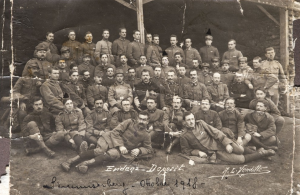EXHIBITIONS The Great War and Italian Jews
There was the envelope with 44 letters and 19 postcards from the frontline. There was the bag that Grandma Graziella Anticoli jealously preserved as a symbol of her childhood with her parents and thirteen brothers in Rome, a childhood made up of small joys and effort.
These items are the core of a huge treasure; extraordinary proof of Italian Jewish involvement in the Great War, that Esther Di Porto, Graziella’s granddaughter decided to share with the Jewish community of Rome.
By a series of fortunate events, this collection gave birth to the exhibition “Prima di tutto, Italiani” (“First of all Italians”), which can be visited at the Jewish Museum of Rome until 16 March 2015.
“I want to emphasize how the idea was became reality rather easily with the help of the entire community,” explained the exhibition curator, Lia Toaff. “We collected archive materials and starting from the letters of Graziella’s brothers from the frontline, expanded our research. We then focused on two main points; the witness of a sense of loyalty of the Roman Jews to Italy after the emancipation and the closing down of the Ghetto, and the preservation of Jewish traditions. In the exhibition, visitors can see documentation regarding requests by the military rabbi for the flour needed to prepare matzos during Passover and the permission to observe Yom Kippur. A harmonious balance between Italian identity and Judaism, which was later swept away by the anti-Jewish laws issued in 1938”.
During the exhibition opening the Italian Minister of Defense Roberta Pinotti said, “There is a detail that I want to bring to light: the aim of the Racist Laws was to remove the identity of the Jewish people. An example? Jews who fought in the First World War, who sacrificed themselves for the country, were stripped of all medals and honors. The greatest humiliation inflicted on them so as to erase their sense of belonging.”
“The letters of the Anticoli family send us deeply into the experience of one of the most difficult and horrific wars in the history of the world,” commented the Museum Director, Alessandra Di Castro. “At the same time, however, they allow for a fascinating journey; in the letters I found the original words used by my grandparents; that being the colloquial language of the Roman Jews.”
Esther Di Porto also told Pagine Ebraiche the fascinating story of her family: “The letters had always been kept by my grandmother Graziella, the youngest of thirteen children, four of whom took part in the war. I started to read and rediscover them only two years ago and immediately I realized their significance. The best idea seemed to entrust them to the museum and I must admit that I am completely satisfied with the work that has been done. The letters, in addition to being an important testimony and legacy of WWI offer a new vision of the life of Rome and Roman Jews at that time; my great-grandfather wrote about the crisis and his work in the bakery as well as about his visits to the Scola, the synagogue, when the Great Synagogue was still under construction. He also considered himself the inventor of almond milk. When he saw it on sale elsewhere, he sadly commented, “But this is my invention!’.”

